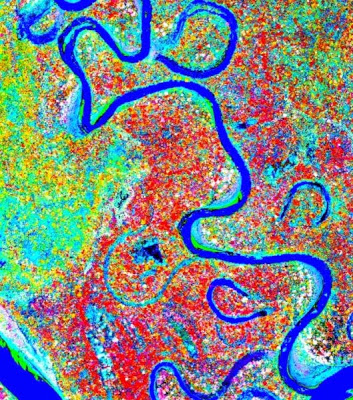
You know the old saying: Location, location, location? It turns out that it applies to the Amazon rainforest, too. New work from Carnegie’s Greg Asner illustrates a hidden tapestry of chemical variation across the lowland Peruvian Amazon, with plants in different areas producing an array of chemicals that changes across the region’s topography. His team’s work is published by Nature Geoscience.
“Our findings tell us that lowland Amazon forests are far more geographically sorted than we once thought,” Asner explained. “It is not simply a swath of green that occurs with everything strewn randomly. Place does matter, even if it all appears to be flat and green monotony at first glance.”
The Amazonian forest occupies more than five million square kilometers, stretching from the Atlantic coast to the foothills of the Andes. Thousands of tree and other plant species are found throughout this area, each synthesizing a complex portfolio of chemicals to accomplish a variety of functions from capturing sunlight to fighting off herbivores, to attracting pollinators, not to mention the chemical processes involved in adapting to climate change.
The lowland forests of the Amazon rest on a hidden, underlying mosaic of geologic and hydrologic variation. It turns out that this mosaic affects the diversity of chemical functions that forest plants undertake, because the varying topography affects water, nutrients, and other plant resources. Understanding how the chemical activity of plants varies geographically is crucial to understanding the way an ecosystem functions on a large scale.
To figure it out, Asner and his team took a high-tech approach based on data collected from their Carnegie Airborne Observatory, or CAO, and developed the first high-resolution maps of the forest’s canopy chemistry. A novel combination of instruments onboard the CAO, including a high-fidelity imaging spectrometer and a laser scanner, was used to map four huge forested landscapes along two Amazonian river systems. The instruments enabled the team to capture previously hidden chemical fingerprints of rainforest canopy species.
“This is the first time that so many chemicals have been measured and mapped in any forest ecosystem on Earth,” Asner said. “No one has done the mapping we have achieved here, which enabled a discovery that the lowland Amazon is anything but monotonous or similar everywhere.”
Their results reveal that the pattern of chemical properties in canopy trees changes along the paths of the two rivers–the Madre de Dios River and the Tambopata River–as well as across the landscape’s topography on a ‘microscale’, with very small changes in elevation making all the difference to the plants living there. CAO’s laser-guided spectroscopic mapping is unsurpassed in its ability to connect biological and geological processes. Studies of this kind help scientists to better understand Earth’s tremendous diversity and its geographic patterning, both of which are required to understand evolution or the future of species in a changing world.
“Looking at the lowland Amazon with this kind of detail, you can see back in time, from the way the topography was shaped millions of years ago, which still affects soils and mineral availability today, to the way that different species evolved to take advantage of this great variety of subtly changing conditions,” Asner explained. “And we can peer into the future and see how quickly human activity is changing the kaleidoscope of diversity that has been uniquely shaped over millions of years.”
Reference:
Felipe Sinca et al. Landscape biogeochemistry reflected in shifting distributions of chemical traits in the Amazon forest canopy. Nature Geoscience, May 2015 DOI: 10.1038/ngeo2443
Note: The above story is based on materials provided by Carnegie Institution.










